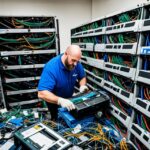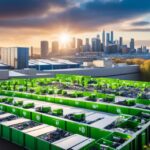The Impact of Server Recycling on Reducing Greenhouse Gas Emissions
In today’s rapidly advancing digital landscape, server recycling is a crucial step towards minimizing our environmental impact. As businesses and individuals increasingly rely on technology, the carbon emissions and electronic waste generated by dedicated servers have become a pressing concern. By adopting sustainable practices in server management, we have the power to reduce greenhouse gas emissions, conserve valuable resources, and contribute to a greener future.
Server recycling not only addresses electronic waste but also plays a significant role in decreasing energy consumption. Dedicated servers consume vast amounts of electricity, contributing to the growing energy demands of the digital ecosystem. By recycling servers and promoting energy-efficient practices, we can curtail our carbon dioxide footprint and lessen our impact on climate change.
Furthermore, embracing server recycling leads to enhanced compliance and brand image. Customers and stakeholders increasingly expect businesses to demonstrate commitment to sustainability. By prioritizing server recycling, companies can showcase their environmental responsibility, attract eco-conscious customers, and differentiate themselves in a competitive market.
Technological innovation is another benefit of server recycling. As we reimagine server management and explore sustainable alternatives, we drive advancements in energy-efficient technologies and renewable energy sources. This innovation helps shape a more sustainable future for the entire tech industry.
Lastly, the economic advantages of server recycling cannot be ignored. By reducing energy consumption and electronic waste, businesses can optimize their long-term profitability, increase their resilience to changing environmental regulations, and reduce operational costs.
As we navigate the digital age, choosing a sustainable server provider becomes imperative. By partnering with companies that prioritize server recycling and environmental responsibility, we align our business operations with the principles of sustainability and contribute to a cleaner, greener world.
The Impact of Dedicated Servers on the Environment
Dedicated servers have a substantial environmental impact due to their energy usage and carbon footprint. These servers consume a significant amount of electricity, drawing attention to the environmental concern of growing energy use in the digital ecosystem. The cooling needs of data centers housing dedicated servers also contribute to the energy-intensive nature of their operations. Furthermore, dedicated servers and data centers contribute to carbon dioxide emissions, which are a significant contributor to climate change.
When it comes to energy use, dedicated servers require a constant power supply to run and provide uninterrupted service. This results in a higher demand for electricity, adding to the overall energy consumption. The challenge lies in finding sustainable ways to power dedicated servers that minimize their impact on the environment.
The cooling needs of data centers are another area of concern. Since dedicated servers generate a significant amount of heat, they require specialized cooling systems to maintain optimal operating temperatures. These cooling systems consume a substantial amount of energy, contributing to the environmental impact of dedicated servers.
Moreover, the environmental impact of dedicated servers extends to their carbon dioxide footprint. The operation and maintenance of data centers, including dedicated servers, contribute to the release of carbon dioxide into the atmosphere. Carbon dioxide is a greenhouse gas that contributes to climate change, making it essential to address its emission in data center operations.
To fully understand the environmental impact of dedicated servers, it is necessary to consider their effects on electronic waste. As dedicated servers become outdated or reach the end of their lifecycle, they contribute to the growing e-waste problem. Proper disposal and recycling of these servers are essential to minimize their impact on the environment and promote a circular economy.
“The environmental impact of dedicated servers extends beyond their energy use and cooling needs. It encompasses the carbon dioxide emissions they generate and the potential electronic waste they contribute to.”
Addressing the Environmental Impact
To address the environmental impact of dedicated servers, businesses and data center operators can embrace several strategies. These strategies can help minimize energy consumption, reduce carbon dioxide emissions, and promote sustainability.
- Implementing energy-efficient technologies and practices, such as server virtualization and optimizing airflow management, can significantly reduce energy use.
- Adopting renewable energy sources, such as solar or wind power, can help data centers transition to more sustainable energy options.
- Optimizing cooling systems with innovative technologies can improve energy efficiency and reduce the environmental impact of data center operations.
- Ensuring proper disposal and recycling of dedicated servers can minimize electronic waste and promote resource conservation.
| Environmental Impact | Strategies to Reduce Impact |
|---|---|
| Energy Usage | Implement energy-efficient technologies and practices. |
| Cooling Needs | Optimize cooling systems with innovative technologies. |
| Carbon Dioxide Footprint | Transition to renewable energy sources. |
| Electronic Waste | Ensure proper disposal and recycling of dedicated servers. |
By adopting sustainable practices and leveraging technological advancements, the environmental impact of dedicated servers can be reduced. Moving towards a greener approach not only benefits the environment but also enhances brand image and demonstrates a commitment to sustainability. It is essential for businesses to prioritize the environmental impact of their digital infrastructure and work towards a more sustainable future.
Strategies for Reducing Greenhouse Gas Emissions in Data Centers
To mitigate the environmental impact of data centers and reduce greenhouse gas emissions, several strategies can be implemented. By prioritizing energy efficiency and embracing renewable energy sources, data centers can make significant contributions to sustainability.
Increasing Energy Efficiency
One of the key approaches to reducing greenhouse gas emissions in data centers is by increasing energy efficiency. This can be achieved through various practices, such as:
- Server virtualization: Utilizing virtual servers allows for better resource allocation, reducing energy consumption and operational costs.
- Airflow management: Implementing effective airflow management techniques optimizes cooling efficiency and minimizes energy waste.
- Free cooling: Utilizing ambient air or external cooling sources, such as cool outdoor temperatures or chilled water, reduces the reliance on energy-intensive cooling systems, thus decreasing energy consumption.
By implementing these energy-efficient practices, data centers can significantly reduce their carbon footprint and minimize their impact on the environment.
Shifting to Renewable Energy Sources
The adoption of renewable energy sources, such as wind and solar power, is another effective strategy for reducing greenhouse gas emissions in data centers. Data center operators can take the following approaches:
- On-site renewable energy generation: Installing solar panels and wind turbines on-site allows data centers to generate clean electricity, reducing dependency on traditional grid power.
- Off-site renewable energy procurement: Data centers can purchase renewable energy from off-site sources through renewable energy certificates (RECs) or power purchase agreements (PPAs), supporting sustainable energy production.
By shifting to renewable energy sources, data centers can reduce their reliance on fossil fuels and make significant strides towards a greener and more sustainable future.
Waste Management in Data Centers
Efficient waste management is a crucial aspect of reducing the environmental impact of data centers. These facilities generate significant amounts of electronic waste (e-waste) and packaging waste, contributing to pollution and carbon emissions. By implementing proper waste management practices, data centers can make a positive contribution to sustainability and resource conservation.
Electronic Waste Recycling
Recycling e-waste is an effective way to recover valuable materials and reduce the demand for new resources. Data centers can collaborate with certified e-waste recycling companies to ensure responsible disposal of outdated servers, storage devices, and other electronic equipment. This not only helps mitigate environmental impact but also promotes the circular economy by closing the materials loop and avoiding waste.
Reducing Packaging Waste
Packaging waste reduction strategies play a vital role in minimizing the environmental impact of data centers. By embracing source reduction, material substitution, and reuse, data centers can significantly reduce packaging waste. Opting for sustainable packaging materials and designing modular packaging solutions can further support waste reduction efforts. These practices contribute to a more sustainable supply chain and help minimize the carbon footprint associated with packaging waste.
“Proper waste management in data centers is crucial for achieving a more sustainable future and reducing environmental harm.”
Circular Economy Principles
Implementing circular economy principles can further enhance waste management in data centers. Product life extension, through refurbishment and remanufacturing, helps prolong the lifespan of equipment and reduces the volume of waste generated. Material recovery and recycling processes ensure that valuable resources can be extracted from decommissioned servers and other electronic devices, closing the resource loop and minimizing reliance on virgin materials.
Waste Management Strategies in Data Centers
| Waste Management Strategies | Description |
|---|---|
| Electronic Waste Recycling | Collaborating with certified e-waste recyclers to responsibly dispose of outdated electronic equipment. |
| Reducing Packaging Waste | Implementing source reduction, material substitution, and reuse strategies to minimize packaging waste. |
| Circular Economy Principles | Embracing product life extension, refurbishment, remanufacturing, and material recovery to reduce waste and preserve resources. |
By adopting comprehensive waste management strategies, data centers can significantly reduce their environmental impact, contribute to resource conservation, and promote a more sustainable digital infrastructure.
The Role of Renewable Energy in Data Centers
Renewable energy sources are playing an increasingly vital role in reducing the carbon footprint of data centers. As the demand for data storage and processing continues to rise, it is imperative for data center operators to prioritize sustainability by harnessing the power of renewable energy.
One effective approach is to generate renewable energy on-site through the installation of solar panels or wind turbines. This enables data centers to produce their own clean energy, reducing reliance on the grid and minimizing the carbon emissions associated with traditional electricity generation methods.
Another strategy is to purchase renewable energy from off-site sources. Data center operators can obtain renewable energy certificates (RECs) or engage in power purchase agreements (PPAs) with renewable energy projects. By supporting off-site renewable energy initiatives, data centers can contribute to the transition towards a low-carbon economy.
The adoption of renewable energy in data centers is not only environmentally beneficial but also demonstrates a commitment to sustainability. It showcases that businesses are actively taking steps to reduce their carbon footprint and mitigate climate change.
Benefits of On-Site Renewable Energy:
- Lower reliance on the grid
- Reduced carbon emissions
- Energy independence
- Cost savings in the long run
Benefits of Off-Site Renewable Energy:
- Supporting renewable energy projects
- Contributing to the growth of the low-carbon economy
- Diversifying energy sources
- Enhancing brand reputation
By embracing renewable energy, data centers can lead the way in sustainable operations and set an example for other industries. The shift towards clean energy sources not only benefits the environment but also presents a significant opportunity for businesses to align their operations with the principles of a greener future.
Water Conservation in Data Centers
Water usage in data centers, particularly for cooling purposes, is a significant concern. In an era where sustainability is paramount, data center operators must take proactive steps to implement water conservation measures and reduce their environmental impact.
One effective approach is the use of air-cooled systems, which offer a greener alternative to traditional water-cooled systems. By employing air-cooled systems, data centers can significantly reduce their water consumption by utilizing air instead of water to cool servers. This innovative technology not only minimizes water usage but also enhances energy efficiency.
Another sustainable practice is water recycling. Data centers can treat and reuse wastewater for non-potable purposes within their facilities. By implementing water recycling systems, data centers contribute to the conservation of water resources, especially in areas experiencing water scarcity.
Embracing these water conservation practices not only aligns data center operations with environmental responsibility but also showcases a commitment to sustainability and efficient resource management. By reducing water consumption, data centers can make a tangible positive impact on the environment while still meeting the demands of digital infrastructure.
| Water Conservation Measures | Benefits |
|---|---|
| Implementation of air-cooled systems | Significantly reduces water consumption |
| Water recycling | Conserves water resources and addresses water scarcity |
| Enhanced energy efficiency | Reduces overall environmental impact |
By adopting air-cooled systems and water recycling practices, data centers can lead the way in sustainable technology infrastructure. These initiatives not only contribute to water conservation efforts but also promote the efficient use of resources, demonstrating a commitment to environmental stewardship.
Conclusion
Data centers play a crucial role in the digital economy, providing the infrastructure and computing power that drives our modern world. However, their operations also have a significant impact on the environment, contributing to greenhouse gas emissions and climate change. It is imperative that we address this challenge and strive for sustainability in data center practices.
By implementing a range of sustainable strategies, data centers can take meaningful steps towards reducing their environmental footprint. Server recycling, energy-efficient technologies, and the adoption of renewable energy sources like wind and solar power all play a vital role in mitigating greenhouse gas emissions.
Additionally, effective waste management practices, such as e-waste recycling and packaging waste reduction, contribute to the circular economy and conserving resources. Water conservation measures, such as air-cooled systems and water recycling, can help alleviate the strain that data centers place on water resources.
To achieve true sustainability, collaboration between governments, data center operators, and the industry as a whole is necessary. Governments must enact and enforce regulations that promote sustainable practices, while data center operators need to prioritize environmental responsibility and embrace the transition to a low-carbon economy.
By taking these steps, data centers can not only reduce their greenhouse gas emissions but also contribute to a more sustainable and environmentally friendly future. Together, we can build a digital ecosystem that is both efficient and responsible, ensuring a brighter future for generations to come.
FAQ
How does server recycling contribute to reducing greenhouse gas emissions?
Server recycling plays a pivotal role in curbing greenhouse gas emissions by decreasing energy use, reducing carbon emissions, and minimizing electronic waste.
What is the environmental impact of dedicated servers?
Dedicated servers have a substantial environmental impact due to their energy usage, cooling needs, carbon footprint, and electronic waste generation.
What strategies can be implemented to reduce greenhouse gas emissions in data centers?
Strategies such as increasing energy efficiency, shifting to renewable energy sources, and implementing sustainable cooling technologies can help mitigate greenhouse gas emissions in data centers.
How can waste management be improved in data centers?
Waste management in data centers can be improved through e-waste recycling, packaging waste reduction, and adopting circular economy principles to minimize pollution and carbon emissions.
What role does renewable energy play in reducing the carbon footprint of data centers?
Renewable energy sources help reduce the carbon footprint of data centers by generating on-site renewable energy and purchasing renewable energy from off-site sources.
How can water conservation be achieved in data centers?
Water conservation in data centers can be achieved through the use of air-cooled systems, water recycling practices, and implementing measures to reduce water consumption for cooling purposes.
How can data centers contribute to sustainability?
Data centers can contribute to sustainability by implementing server recycling, adopting energy-efficient strategies, embracing renewable energy sources, practicing waste management, and conserving water resources.















